Can You Mothproof Your Carpets?

Everyone knows that moths can get into closets and destroy all kinds of clothing. However, many people forget that moths often target other kinds of fabrics as well. In fact, some species of moth can even destroy the carpets in your house! No one wants to find Moth Larvae eating through their carpets. Whether the larvae are attacking your decorative rugs or munching on the actual carpet installed in rooms throughout your home, the struggle is definitely real.
For some infestations, the carpet may need to be removed and replaced altogether. For other infestations, treatment is possible. Ideally, you will still be in the prevention stage. As they say, a good defense is the best offense!
To prevent moths from turning your carpets into lunch, there are a few things you can do. You need to know your enemy and take preventative measures to keep them from invading your home! That is exactly what we will talk about here. Read on to find out how to moth-proof your carpets, treat existing Carpet Moth infestations, and more.
Carpet moths: where do they come from, and what are they?
Case-bearing Moths, sometimes also known as Carpet or Tapestry Moths, are also known as Webbing Clothes Moths (Tineola Bisselliella) or Case-Bearing Clothes Moths (Tinea Pellionella). These moths can be found in every country of the world. They have wingspans of 14-18 mm, light-colored heads, and yellowish-white and gray wings. These pesky insects are most active from June to September, depending on where you live in the United States or Europe.
The larvae of this moth species will feed on wool, fur, natural fiber clothing, furniture coverings, tapestries, animal skins, feathers, and yes, carpets. The cycle of a Carpet Moth starts and ends within one year. Similar to Webbing Clothes Moths, Case-bearing Carpet Moths spin webbing in areas where they reside. The life cycle of Carpet Moths depends entirely on the humidity, temperatures, and available fabrics in the location they inhabit.
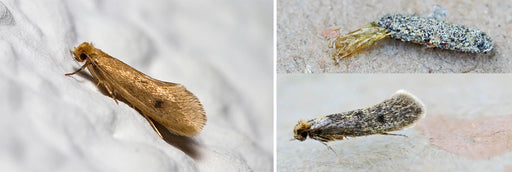
How do you mothproof a carpet?
Your carpets are probably an integral part of your home and interior decor. As such, having holes burrowed through them can be very frustrating! For this reason, Carpet Moth prevention is essential as the only mothproof carpet is a synthetic one!. Regular moth-proofing methods are advised for all carpets that contain natural fibers and usually, this should involve protecting or treating your home as a whole.
Many natural remedies can also be used to deter moths from infesting carpets. These include cedar, lavender, mint, bay leaves, rosemary, and thyme. Most natural remedies, sprays, and powders may need to be refreshed regularly until there are no longer any moths anywhere in your home.
Preventing moths from entering your home in the first place is a major step to keeping those Carpet Moths at bay. Do not leave doors or windows open in the evening. Use Moth Traps to catch adult male moths before they can breed and the females lay eggs in your carpets, upholstery, and clothing. If you have a moth infestation anywhere else in your home, be sure to treat it before it spreads to your tapestries or carpets.
To Deter Carpet Moths:
- Prevent moths from coming in
- Use deterrents such as natural herbs
- Use moth sprays and powders
- Place Carpet Moth Traps around your home to help break the breeding cycle
- Clean your carpets and vacuum regularly
- Choose carpeting made of synthetic materials

How do Carpet Moths get in your house?
Carpet Moths can enter your home in various ways. These pests can trouble homeowners in old houses or brand new ones! Sometimes, Carpet Moths hide in clothing or furniture purchased from thrift stores, consignment shops, or garage sales. They can also get into your home through cracks and vents. Or, they might just fly in through an open door or window.
In many cases, moths will be in older homes with dark, quiet places in attics or storage spaces. This is why it is important to treat your whole house if you notice Carpet Moths under the furniture or along the baseboards. Carpet Moths are usually drawn to dark, quiet places. The gap where a couch is pushed up against the wall in a rarely used room is a good example.
Another common way that Carpet Moths enter homes involves the house construction process. As a house is being built, many places are left exposed to the open air. During this time, carpeting is sometimes carried in and stored out of the way for future installation. Most of the time, the new carpet will be wrapped in plastic. However, rips and tears in this plastic are possible. At this point, moths can get into new carpets and lay eggs before installation even happens. Moth eggs are sticky and will cling to the fibers of the carpet. Later, when the carpeting has been installed, the eggs hatch.
About Wool Carpet Moths
Carpet Moths love natural fibers. The adult moths don’t actually eat anything. It is the larvae that you want to worry about. Carpet Moth Larvae eat the keratin proteins. These proteins can be found in wool. Therefore, If you have silk or wool carpets in your home, moth infestations are more likely.
Identifying Moth Larvae in Carpet Fibers
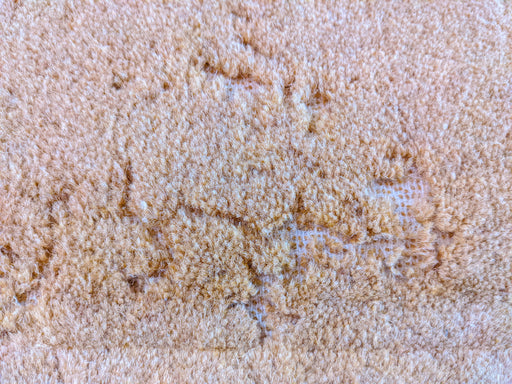
If you see signs of moths in your home, do not hesitate to treat them right away. The sooner you rid your home of moths, the less damage there will be to fix later. If you notice that your carpet is developing threadbare patches, it might be because larvae are chewing through the fibers when things are still and quiet.
You might find tubular case trails as evidence. These tubular cases are usually delicate and thin, with a cylindrical shape and brownish color. If you suspect that Carpet Moth Larvae are feasting on the fibers of your carpet when no one is around, check near dark sections in the room to find where they are hiding. Look under any heavy furniture, near your baseboards, or around any items pushed up against the wall.
Unfortunately, larvae can also be underneath the carpet. If the carpet is installed permanently, it can be difficult to clean beneath. Check your vacuum bag for dead moth larvae or casings. If you only ever see evidence in the vacuum, they could be underneath the carpet.
Eliminating moths at the source is an important part of treating an infestation. If all else fails, you can use moth bombs or fumigation to treat an entire room. This will ensure that wherever those moth larvae are hiding, they are no longer having a good time.
- Look for dark crevices
- Check under the furniture
- Search near baseboards
- Check your vacuum tank or bag
- Consider treating the entire room
How to Remove Carpet Moths
Rugs are usually the root cause of a Carpet Moth infestation. This is especially true if you bring rugs back from a vacation destination or inherit them. Used rugs are prime real estate for Carpet Moth Eggs! Rugs can be heavy or logistically difficult to treat. Carpets that have been permanently installed in the home are equally difficult to care for and could necessitate fumigation. Here are some steps to take to remove Carpet Moths in your house.
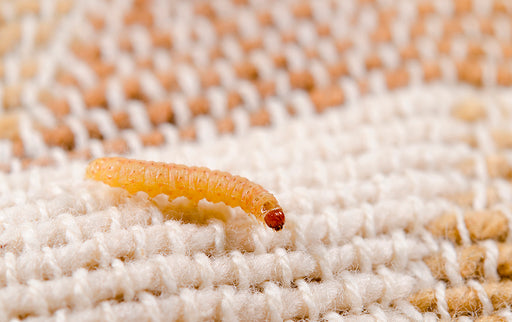
Step 1: Identification
First, you have to figure out the source of the Carpet Moth infestation. Which rug is infested? Is the infestation beneath your carpet?
Step 2: Pick Your Preferred Solution
Many aerosols and sprays are available to treat rugs and prevent future infestations. Some moth-killing sprays create an odorless, clear, non-sticky, coating that remains toxic to moths, eggs, and larvae, for up to a month.
Step 3: Get in Position
Now, you need to either remove the rug or position yourself in a place where you can treat it. If at all possible, move the rug outdoors. The goal is to treat the infested area with minimum disruption to the rest of your home. Remember to treat the underside of a rug or carpet, as this is a very good place for eggs and larvae to hide.
Step 4: Spray or Fumigate the Rug to Kill Eggs and Larvae
Now, it is time to carry out the treatment. You can use moth bombs in an enclosed area or fumigate an entire room with the doors and windows closed. If the infested rug can be carried outside, you may be able to treat it with a moth-killing spray or powder. Be sure to spray the underside of the rug thoroughly. After the treatment is done, be sure to clean and vacuum the rug as well. This will remove any eggs or dead larvae.
Step 5: Prevent Reinfestation
Many awesome natural remedies, aerosol protection products, and sprays can be used to prevent re-infestation. Vacuumable moth-killing carpet powders can also be used. All these are effective ways to prevent moth re-infestation from occurring.
- Check your rug for signs of moths every day
- Vacuum daily at first
- If after a week you see fresh moth larvae activity, consider repeating the fuming process
- Repeat these processes after a month to ensure that the moths are really gone
Additional Carpet Mothproofing Tips
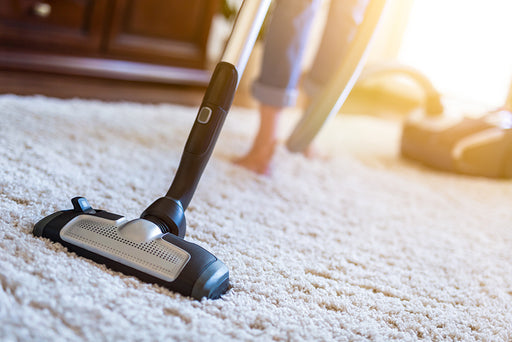
- Vacuum every area and a room thoroughly. Move furniture out of the way and vacuum underneath it before putting it back. Use the nozzle of your vacuum to thoroughly clean along baseboards or in hard-to-reach areas. These hard-to-reach areas are precisely where moth larvae like to hang out! Make sure to empty out your vacuum cleaner to prevent spreading eggs from one area of your home to another. You can also use moth-killing powder and then thoroughly vacuum the area.
- Fumigation helps deal with most residual moth larvae or adults lurking in your home. If you are not sure where an infestation is coming from, you may need to fumigate each room separately.
- If you decide to rip up old or damaged carpet, it may be wise to replace its underlay as well. This underlay is likely to have deteriorated anyway. Make sure to take any carpet out of your home wrapped in plastic. That way, you don't accidentally spread eggs throughout your house.
- Before installing new carpet or underlay, clean and vacuum the floor. There are many odorless non-staining protective sprays that you can apply along the edges of your flooring. Apply moth powder to skirting boards and leave it on overnight if possible. Then, vacuum it all up before putting in any new carpeting.
- Use moth traps or moth tape to ensure that no adult moths get in and begin laying eggs on, in, or under your brand-new carpets.
Carpet Moths FAQs: Here’s What to Know
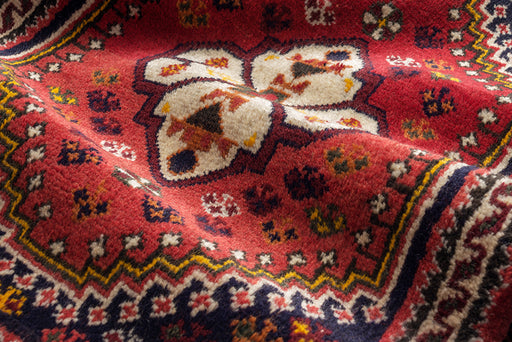
Here are a few final frequently asked questions about preventing and eliminating Carpet Moths in your home.
What is the best carpet to avoid moths?
Moth larvae eat natural fabrics and fibers. This can include wool, leather, feathers, and fur. Sheepskin rugs or rugs that are made using woolen fibers are particularly prone to moth infestation. So, if you want a moth-proof carpet, make sure to choose one that does not use any kind of woolen materials, animal products, or natural fibers.
Some people love the feel of genuine wool carpets. Luckily, many manufacturers automatically moth-proof natural fiber carpets before selling them. The companies Penthouse and Telenzo both sell some lovely moth-proof wool carpets. Most synthetic fiber carpets are also inherently moth-proof.
How do I stop moths eating my carpet?
To keep moths from eating your carpet, be sure to prevent them from entering your home in the first place. Close your doors and windows at sunset or position Moth Traps to catch adult moths before they can lay eggs. Moth bombs, sprays, powders, or fumigation products can eliminate existing Carpet Moth infestations.
Vacuum cleaners and moth-killing carpet powder can also help you get rid of moths. Be sure to vacuum under any furniture or in dark areas. Shake out rugs and pillows, or store them in the freezer for up to 72 hours. Cleaning regularly and thoroughly can go a long way toward keeping moths from destroying your interior decor.
What do Carpet Moths hate?
Moths and many other insects are repelled by the pheromones in various natural materials. Cedar is particularly off-putting to moths. You can combine cedar, rosemary, cloves, and thyme in satchels. Hang them near your doors, drawers, cabinets, windows, or other areas where moths might be present.
Moths Hate:
- Cedar
- Rosemary
- Mint
- Thyme
- Cloves

Carpet Moth Prevention & Removal: Final Thoughts
Now you know how to prevent, remove, and treat Carpet Moths! Remember, the best way to keep your carpets safe is to take preventative measures against allowing moths to enter your home in the first place. That way, you can avoid carpet damage entirely. Hopefully, these tips have been enlightening, and you can keep your carpets looking fresh and new!
About MothPrevention
MothPrevention® speak to customers every day about their clothes moth issues - clothes moths are a species that are ever increasing and that can cause significant damage to clothes, carpets and other home textiles.
To date, we’ve helped over 250,000 customers deal with their moth problems. We have developed professional grade solutions including proprietary pheromones and trap design, not available from anybody else in the USA.





